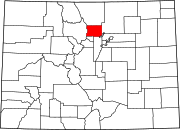Sugarloaf, Colorado
Sugarloaf, Colorado | |
|---|---|
 Location of the Sugarloaf CDP in Boulder County, Colorado. | |
Location of the Sugarloaf CDP in the United States. | |
| Coordinates: 40°01′08″N 105°24′28″W / 40.0188747°N 105.4076689°W[1] | |
| Country | |
| State | |
| County | Boulder County |
| Government | |
| • Type | unincorporated community |
| Area | |
| • Total | 2.178 sq mi (5.640 km2) |
| • Land | 2.178 sq mi (5.640 km2) |
| • Water | 0.000 sq mi (0.000 km2) |
| Population | |
| • Total | 274 |
| • Density | 130/sq mi (49/km2) |
| Time zone | UTC-7 (MST) |
| • Summer (DST) | UTC-6 (MDT) |
| ZIP Code[4] | Boulder 80302 |
| Area codes | 303 & 720 |
| GNIS feature[2] | Sugarloaf CDP |
Sugarloaf (also spelled Sugar Loaf) is an unincorporated community and a census-designated place (CDP) located in and governed by Boulder County, Colorado, United States. The CDP is a part of the Boulder, CO Metropolitan Statistical Area. The population of the Sugarloaf CDP was 274 at the United States Census 2020.[3] The Boulder post office (Zip Code 80302) serves the area.[4]
History
Sugarloaf, sometimes spelled Sugar Loaf, Boulder County, was referred to in Colorado historical records dating back to 1868. It seems the early name came from a mining claim referred to as "Sugar Loaf, near Yellow Pine."[5] Sugar Loaf seems also to have been a term for a mining district, of multiple mining claims.[6]
In 1989, a destructive wildfire swept up and across much of Sugarloaf burning 2,100 acres (850 ha), destroying 44 houses and other structures, and causing approximately US$10 million in damages.[7] The Black Tiger Fire"was the worst wildland fire loss in Colorado history"[8] at the time. It was a human-caused fire that started 9 July 1989 in a scenic mountain area at the base of Black Tiger Gulch and swept up to the summit of Sugarloaf Mountain through residential areas that were "nestled among the trees. Within the first five to six hours after ignition, 44 homes and other structures were destroyed and many others were damaged."[8] Some fire fighters of the Sugarloaf Volunteer Fire Department had their own homes destroyed during the fire. Although there were a number of minor injuries, there were no fatalities from the fire.[8]
Geography

Sugarloaf is located in south-central Boulder County, approximately halfway between Boulder and Nederland. It is bordered by the Mountain Meadows CDP to the northeast, and North Boulder Creek forms part of the southern edge of the community. Sugarloaf Road is the main route through the CDP.
The Sugarloaf CDP has an area of 1,394 acres (5.640 km2), all land.[1]
Demographics
The United States Census Bureau initially defined the Sugarloaf CDP for the United States Census 2010.
| Year | Pop. | ±% |
|---|---|---|
| 2010 | 261 | — |
| 2020 | 274 | +5.0% |
| Source: United States Census Bureau | ||
Town organizations and events
Sugarloaf has a volunteer fire department—as of 2019, the department typically runs 30 to 45 members—which is a part of the Sugar Loaf Fire Protection District (SLFPD) covering approximately 17 square miles (44 km2) of territory, 500 homes, with land between 6,000 to 8,500 ft (1,800 to 2,600 m) elevation in mountainous terrain. The VFD was initially formed in 1967,[9] and in 2019, serves approximately 1400 persons.[10][9]
See also
References
- ^ a b c "State of Colorado Census Designated Places - BAS20 - Data as of January 1, 2020". United States Census Bureau. Retrieved December 12, 2020.
- ^ a b c "U.S. Board on Geographic Names: Domestic Names". United States Geological Survey. Retrieved December 12, 2020.
- ^ a b United States Census Bureau. "Sugarloaf CDP, Colorado". Retrieved April 18, 2023.
- ^ a b "Zip Code 80302 Map and Profile". zipdatamaps.com. 2020. Retrieved December 20, 2020.
- ^ The Real Pioneers of Colorado, Maria Davies McGrath, 1934. Retyped in 2001 to make available on the internet. Accessed 26 October 2019.
- ^ https://cudl.colorado.edu/luna/servlet/detail/UCBOULDERCB1~85~85~1100589~141522:Sugar-Loaf-Mining-District
- ^
"The Black Tiger Fire". Disasters / Wildfires. Boulder County. Retrieved October 26, 2019.
The Black Tiger Fire occurred in 1989, in the foothills of Boulder County northwest of the City of Boulder. At the time, it was the most destructive wildfire in terms of property loss and damage in Colorado history. The fire burned almost 2,100 acres. 44 homes and other structures were destroyed and several others damaged. Loss estimates of homes and natural resources amounted to $10 million, and the cost to control the fire was another $1 million. More than 500 fire fighters from local, state and federal fire agencies worked to eventually contain the fire and protect the numerous other homes built in the rustic surroundings. Some of the fire fighters' own homes were threatened or destroyed by the fire. Only a few minor fire fighter injuries were reported and one resident was hospitalized from burns.
- ^ a b c "Black Tiger Fire Case Study" (PDF). Fire investigations. NFPA fire investigations - Natural disasters. Quincy, Massachusetts: National Fire Protection Association. 1990.
- ^ a b "SLFPD". Retrieved October 27, 2019.
- ^ https://www.timescall.com/2019/07/20/boulder-countys-rural-fire-stations-depend-on-volunteers-to-protect-communities/


